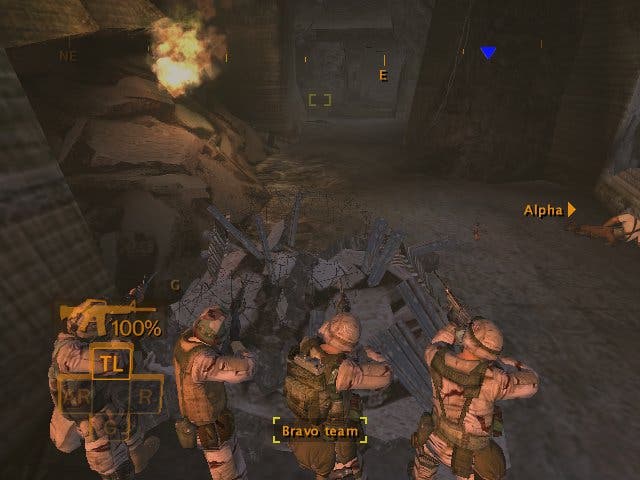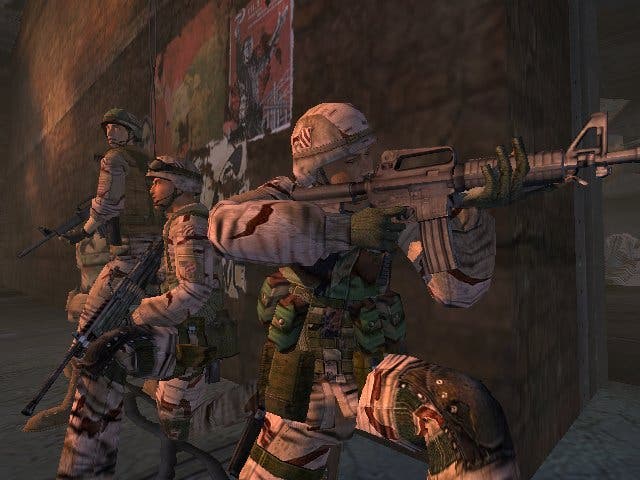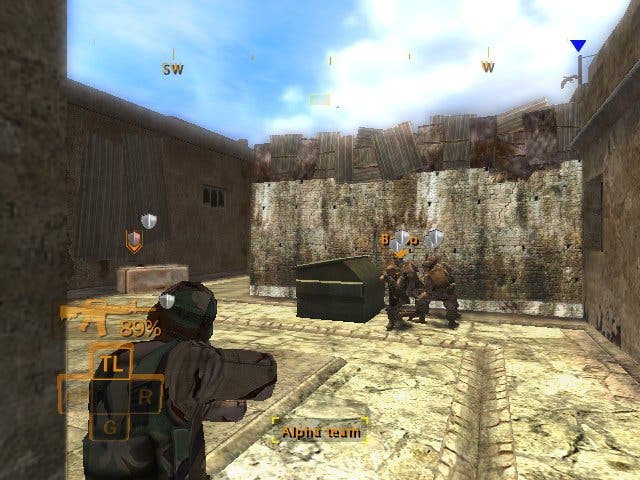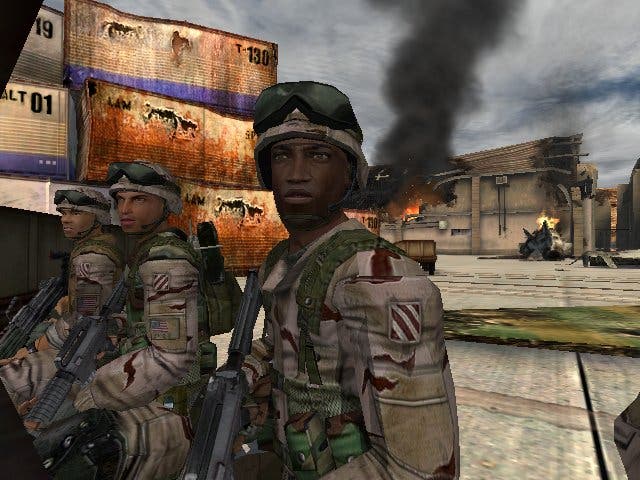Full Spectrum Warrior Review
Bored of shooters that never do anything new? This is the antidote.
Games often affect us in strange ways. Tetris changed the way we organised things in our car boots, Gotham left us veering dangerously close to parked cars for fear of losing Kudos, and, today, Full Spectrum Warrior has us throwing ourselves up against the corners of walls, and judging everybody we meet based on how much cover they have [I still got a headshot -Ed]. It's just as well we don't buy into the whole gang culture thing that's quite prevalent down our way, or we might be writing this review from a hospital.
Rubbish intro jokes aside though, FSW has changed the way we view certain things - third-person action games being the most obvious example. Watching a flatmate play a generic third-person shooter recently, we realised we were looking at the environment differently, seeking out obvious cover points, assessing how much damage certain things could withstand, and looking for the most obvious route to flank entrenched opposition. It's rare for an over-the-shoulder shoot-'em-up to foster so much strategic thinking, and we've taken to it like the US government to unilateral action.
Stayin' alive

It's a genuinely interesting approach. Pandemic's latest is, simply put, a third-person action game in which you never pull the trigger. Instead, you direct the battle as a phantasmic unit commander, directing two squads of four men to move between cover points, suppress enemies, and - most significantly - avoid damage. Real life armed forces tend to try and avoid killing their own troops through the sorts of gung ho lead-fest tactics that dominate the landscape of action games, and as a genuine US Army contractor, Pandemic Studios has managed to supplant the realistic need to avoid exposing troops to fire and craft an absorbing, strategic action game out of it - without resorting to eye-in-the-sky RTS conventions either.
Using simple, genuine tactics, you're expected to navigate your way through 11 missions in the fictional middle-eastern country of Zekistan. We'll give Pandemic the benefit of the doubt here and ignore the parallels with real life conflicts, because apart from a couple of dodgy moments involving mass graves, this definitely isn't a piece of propaganda. It's a training tool that just happened to work rather well as a game. And in the game, your 11 missions involve, on average, a lot of moving between cover points (in fact, you're almost never in the open), using one squad to suppress a shielded adversary long enough for the other to work its way around and flank him; the odd rescue mission, which forces you to consider how best to proceed when one of your valuable squad members is tied up carrying a non-combatant; marking targets for bombardment by getting up close and then radioing in coordinates; escorting engineers and other tertiary units to their objectives unharmed; and, towards the end, working out how to deal with larger 'technicals' (vehicles) and the constant threat of the dreaded Rocket-Propelled Grenade ('RPG'). Or worse.
Guts and glory

The whole shebang is presented in glorious visual and aural detail - it kind of looks like all those Delta Force screenshots always did, except in this case it actually delivers, and the banter between troopers (whilst clichéd) never gets in the way or feels out of place, while the surround sound effects can be positively jarring. Visually, environments aren't always texturally extravagant, but the use of destructible scenery (like cars and crates that visibly degrades and soak up bullet holes as they come under fire), some nice, billowing dust and smoke effects, and organic, believable animation routines for your various troopers more than suffice.
We were also impressed by the seamlessness of it all - particularly the use of vehicles. If a chopper hovers over a hotel to deposit some Rangers (as it does in one scenario), you see the blades spinning, you see it bank and move realistically, you see lines chucked out of the side, you see Rangers emerge, and you see them actually grip the lines as they zip down to the rooftop. It rarely looks anything less than believable, even if you could waggle a finger at the odd clipping issue or man-through-wall glitch - and on the latter point, it only seemed to happen to us during 'game over' animations (and very rarely at that), at which point it's somewhat difficult for it to have any gameplay connotations.
Indeed, it's a battleground upon which you rarely have to worry about anything other than your actions. In this profession, we so often find ourselves frustrated in games by technical factors beyond any semblance of logic or our control, but that's rarely the case in Full Spectrum Warrior. Path finding is so rarely an issue that it feels churlish to draw attention to it, and if we ever died it was our own fault, which is the crucial thing. What's more, whenever we died, it was because we didn't follow rule number one: remember your training.
And you will come back alive

That's because everything you will ever physically do to the control pad playing Full Spectrum Warrior is mapped out for you before you ever step foot into a live scenario. Through a mandatory tutorial, the game introduces you to every element, starting with the composition of your two squads. Each of these is comprised of a Team Leader (point man with an M4, and the guy barking the orders), Rifleman (touting an M4), Grenadier (with M203 grenade launcher and a finite number of these devastatingly useful projectiles) and Automatic Rifleman (packing a chunkier M249). Each man also has a supply of frag and smoke grenades. From here, the tutorial shows you how to look around - using the D-pad to select whichever soldier you fancy, the right analogue stick to rotate the camera, left trigger to zoom in, and Y to switch between squads to get a different perspective. Movement is handled using a cursor on the floor, which you control with the left analogue stick. Dragging it around takes a little getting used to, and the camera's not always perfect for this, but before long it's second nature, and in conjunction with a small panel in the bottom right of the screen it allows you not only to select where to send your men, but also the positions they will assume, whether it's up against the edge to peep round and check for enemies, grouped in a pack behind cover on open ground, or something else. You quickly learn the practicalities of each position.
The tutorial then shows you how to move under duress. If you can't see an enemy up ahead but don't want to take any chances, you can move two men at a time whilst two others cover a particular direction. If you can see the enemy, you can suppress him - forcing him to cower behind his cover - which costs ammunition but allows your other squad to scamper round to a more advanced cover point. Besides these basic tactics, you also learn how to make use of grenades (which are quite precise to aim, pleasingly), use the fog-of-war control to check where your squad can and can't see effectively, make use of your GPS tracker to map out routes around the terrain, and call for assistance - either radioed updates on your orders, or perhaps requesting a flyby from a chopper, who marks some of your enemies' current positions on your GPS screen.
Enemy spotted

With that (and a few other subtleties), you're sufficiently grounded to tackle virtually every scenario in the game. As you land in Zekistan, you quickly learn to apply your training effectively, making full use of your resources under pressure, and learning which tactics to apply in certain situations. To begin with, that will be suppression and flanking. Enemies will pop up in small clusters of one or two, and you will suppress them with one squad whilst the other moves to more advanced cover, then perhaps swap roles to advance the other team, and eventually circle round to take out the 'Zekes'. You may even have to improvise a little, tossing a grenade if you can't get close enough, or - a bit later on - even retreating and using the GPS to establish a more effective, safer plan of attack, perhaps moving through completely different alleyways to reach your objective.
Around midway through the game's 11 missions, the difficulty ramps up. The difficulty curves quite gently upward for the first few missions - the developer clearly aware that you're grappling with a new gameplay idea for the first time - and gradually starts thrusting harder and less obvious scenarios upon you. Early criticism of the game in some quarters has focused on the lack of evolution in terms of out and out control, but as we neared the end of the game we felt that there had been an evolution - in tactics. Early scenarios are not the same as latter ones, simply because there are far more factors to consider and strategies have to be more complex. Never to the point that it feels like hard work, but certainly to the point that your blood pumps faster with every pad-shaking RPG impact and sight of a mobile technical. These are armoured on the front and require a wider flanking manoeuvre using more of the terrain to your advantage - another example of changing tactics on the fly.
Charlie 90: report

It's a game that requires you to think in advance of what you're going to do, then execute the plan. It also toughens up around the edges, and again there's a degree of logic to how it does this. At first, you might suppress until your second unit is in position, ceasefire, switch back to the other unit, and start suppressing again. But after a while, that pause in action midway through the cycle gives the enemy enough time to chuck a grenade, or level an RPG round at the flimsy, broken down car you're perched behind - and you have to start using constant fire to avoid this.
Fortunately, this process of learning is eased by a forgiving and very well thought out checkpoint and health system. Quite simply, whenever you finish a significant engagement or objective, the game spawns a checkpoint, and by moving your troops within a certain radius of it, one of the Team Leaders with radio in a "Sit Rep" (or Situation Report) and your progress will be saved. Furthermore, because your soldiers aren't meant to take damage, you rarely have to worry about fixing them up, which means progress is pretty consistent.
Of course, should one of your squad-mates take a bullet because you made an undisciplined decision and went one cover point too far, and you don't feel like reloading the previous checkpoint (which is the obvious thing to do given their abundance), you can hoist them up and return them to the nearest CASEVAC medical unit, allowing you to retool and revitalise injured soldiers.
Coalition of the Live-ing

It's a refreshingly different set of scenarios as a result of all this. And of course you can take it one step further by going online, surrendering control of one of your squads to another Xbox Live user. However, it's worth pointing out that FSW is a game best played by people who know each other, as it requires far more tactical discussion than your average online game - even a co-operative shoot-'em-up. Something like Quake, for example, might let you race through levels with a pal, but if you're hiding up against walls, leaping out and suppressing fire it's because you feel like it, not because there's an enhanced threat if you don't. Really the goal is just to blow things up as explosively as possible, and that doesn't require much more than the odd "woot" or "owned" style comment via voice.
FSW is another thing entirely. Actions and tactics need to be thought out, explained, and put into practice. Squads need to be carefully positioned. You may be playing against the AI, but on harder difficulty levels there's no room for error. It's just a pity, you could say, that there aren't any online-specific missions. Since the game is about two squads anyway, the online mode just recycles the 11 scenarios from the single-player game. Good news if you enjoyed them, bad news if you were sick of the sight of them when you finished. Fortunately, we were in the former camp, but we still felt a pang of disappointment. Perhaps the promised downloadable content will liven things up a little. One thing we do hope, though, is that Pandemic doesn't listen too hard to complaints about the lack of a competitive mode, because it just isn't that sort of game. Maybe if it was turn-based then competitive scenarios would suit, but as a real-time strategic action game, competitive squad-based combat would not work. It really isn't what the game is about and would require a very different dynamic.
Chinks in the armour

Of course, for all its achievements, there are certain things to be said against Full Spectrum Warrior. It's arguably the first of its kind, after all, and as a result there are some things that need addressing before it returns for its inevitable (and worthy) second tour of duty. Firstly, there's the argument that it's too rigid and contrived. It's an understandable point, because the game is built upon a very clear set of rules. Enemies and allies behind cover with a shield icon cannot be hit without adjustment from the opposition - unless, that is, their cover is destructible, in which case it can only take a certain amount of fire before they start to soak it up. As a result, there are occasions when the game's computed view of what's shielded and what's not doesn't always completely align with what you can actually see. This has the potential to frustrate some people. It didn't bother us, because we grew to accept the rules, and it's a fairly rare occurrence anyway, but it's worth pointing out nevertheless.
Slightly more worthy of criticism are some of the developer's choices of enemy positions, and their response to certain scenarios. The use of enemy snipers in high-rise buildings is poorly judged for two reasons - on the one hand, you can only really hit them with a well aimed M203 grenade round, which often doesn't work anyway; and on the other, you can't clear buildings. There are a couple of occasions where you're moving through narrow corridors at the base of a building, but you never actually go inside, kick down a door and clear rooms. It's a limitation, of course, but it's not something that you tend to notice until the developer starts using these unassailable snipers. We wouldn't mind avoiding them completely if there were also an option - however time-consuming - to tackle them from inside, but being forced to avoid them because the game doesn't allow you to enter buildings can be irritating. Their position in the sky also highlights another issue - all the levels are flat. There are no hills - nothing of the sort. Hopefully, again, it's something that Pandemic will take into consideration next time it hits the drawing board, because it might add something.
There's also the question of longevity. Apart from a harder difficulty mode, there's only really an unlockable version of the original US Army training simulator to provide our kicks after the endgame. Even this, which consists of six new scenarios and countless configurable options to vary the experience, fails to excite, as the controls are different, and it's much rougher round the edges and less entertaining. It is fascinating to fiddle with for a few minutes, given the gravity of the tool in your hands, but it's not been designed to keep you entertained. So don't expect it to. With this in mind, you're left with ten or so hours and any more time you fancy putting in online. And the chances are that you, like us, will be left wanting more. That's better than growing bored before it ends, of course, but it's still not perfect.
Commanding
Not perfect, then, but Full Spectrum Warrior is nevertheless a commendable achievement. Apart from the fact that it's a largely seamless gameplay mechanic, sensibly balanced and gloriously fresh and interesting to play, it's also an ingenious premise that deserves further exploration - indeed, this is one of the few times you'll see us crying out for a sequel. Think about it this way - if Full Spectrum Warrior were a standard squad-based shooter, we would control the Team Leader and run around gunning down enemies with relatively little difficulty, racing up to checkpoints and admiring cut-scenes before rinsing and repeating. And it would be boring. As it is, Pandemic has crafted something closer to a puzzle game in spirit, which sometimes does feel contrived, and doesn't always hit the target, but is sufficiently original, and builds on its own ideas thoughtfully and carefully enough that it almost always gives you a sense of satisfaction when you make progress. If you're an action man crying out for a change of pace, then Full Spectrum Warrior is clearly the answer.

